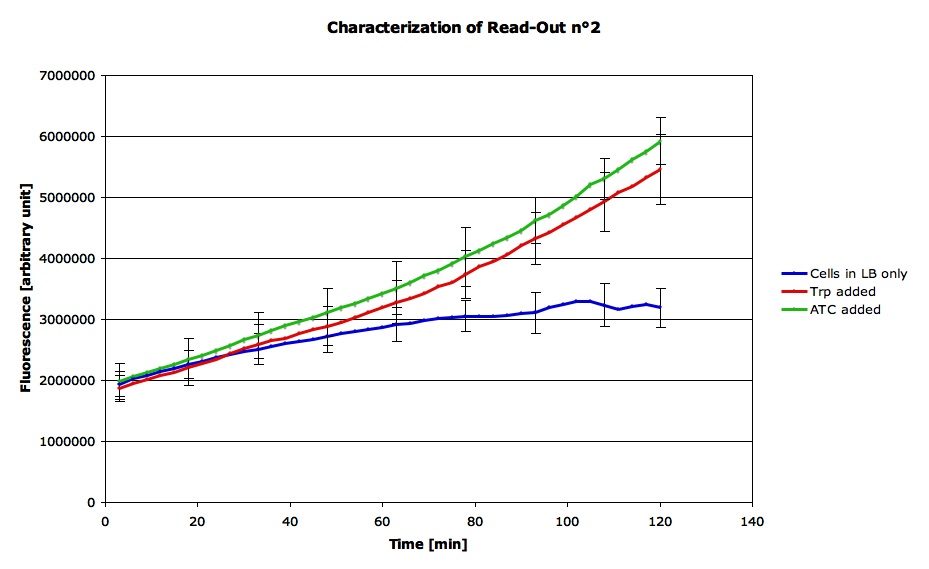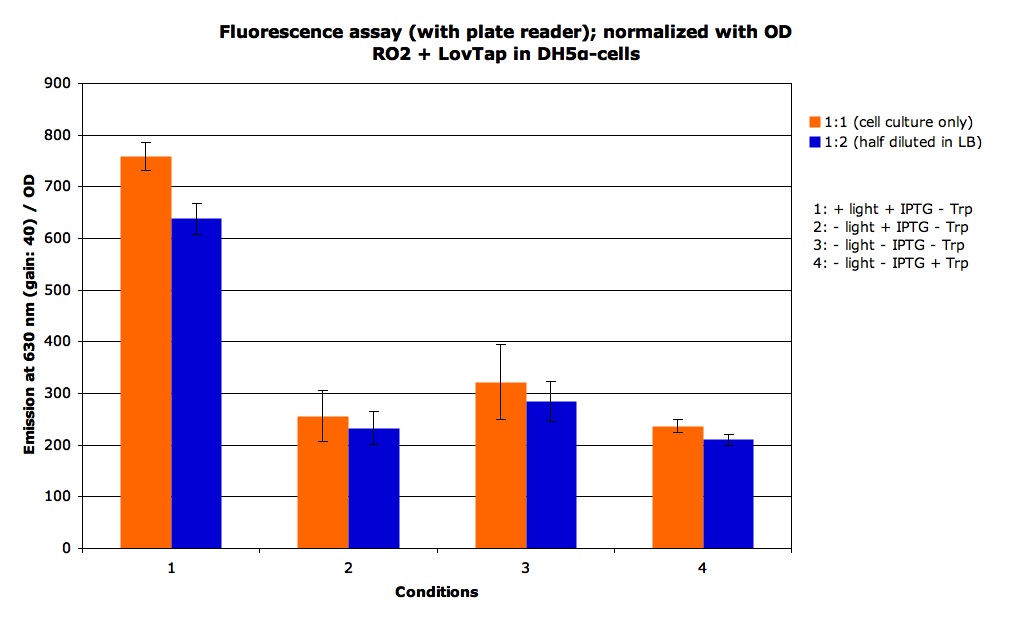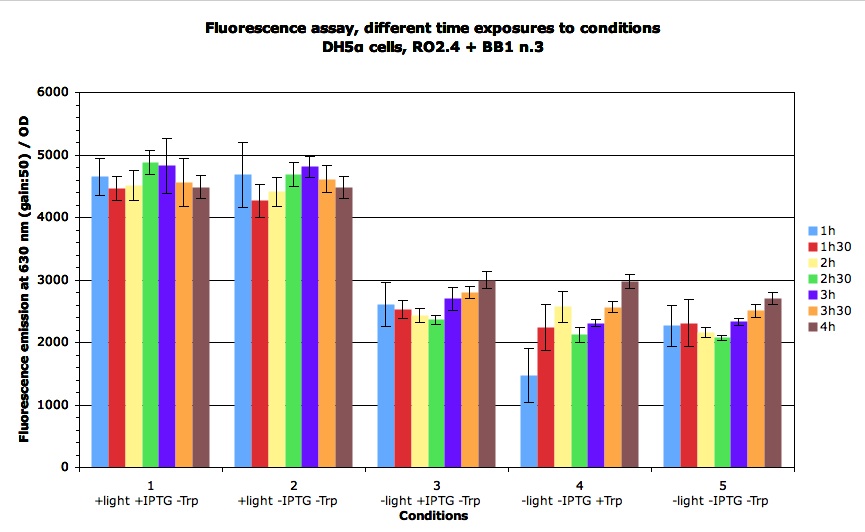Team:EPF-Lausanne/LOVTAP Results
From 2009.igem.org
(→Characterization of Read out 1) |
(→Characterization of Read out 1) |
||
| Line 23: | Line 23: | ||
* Normalized the OD of all flasks to 0.06 by adding the appropriate amount of fresh medium. | * Normalized the OD of all flasks to 0.06 by adding the appropriate amount of fresh medium. | ||
* Prepared the plate for the measurements with the qPCR machine, 50 ul per well. | * Prepared the plate for the measurements with the qPCR machine, 50 ul per well. | ||
| + | |||
| + | |||
{| class="wikitable centre style="text-align:center; width:80%; style="border:5px double black;" | {| class="wikitable centre style="text-align:center; width:80%; style="border:5px double black;" | ||
| Line 42: | Line 44: | ||
| Without Atc nor Trp | | Without Atc nor Trp | ||
|} | |} | ||
| + | |||
| + | |||
For the tryptophane, we used a 4.25 g/L solution. For ATC, it was a 500 ng/mL solution in 50% EtOH, and for IPTG, we always added it so as to have a final concentration of 1mM. | For the tryptophane, we used a 4.25 g/L solution. For ATC, it was a 500 ng/mL solution in 50% EtOH, and for IPTG, we always added it so as to have a final concentration of 1mM. | ||
In the table above, you can see all the conditions that were tested. For Trp, 1/2 corresponds to 1 ul, for ATC to 0.5 ul. | In the table above, you can see all the conditions that were tested. For Trp, 1/2 corresponds to 1 ul, for ATC to 0.5 ul. | ||
| + | * The plate was then loaded into the qPCR machine, which took a kinetic measurement of red fluorescence, and giving the graphs you can see below. | ||
Revision as of 18:58, 20 October 2009
Contents |
Results
Characterization of Read out 1
Our first read-out system consists of the Trp promoter followed by the RFP gene. In E. coli, the Trp promoter is situated in front of the Trp operon, which contains the genes necessary for the tryptophane biosynthetic pathway. In brief, genes placed after the Trp promoter should be repressed in the presence of tryptophane.
To characterize this biobrick, we cultured the cells in a medium without tryptophane: M9 medium to which we added all other amino acids and thiamine. You can find the protocol for the M9 medium here. The purpose of the experiment was to see the difference of RFP expression depending on whether we added tryptophane to the medium or not.
Protocol
- Cells containing the read-out system were cultured overnight in M9 medium.
- On the next day, re-inoculated 0.75 mL of cell culture into 25 mL of fresh medium in an Erlenmeyer flask. Incubate for 2 hours at 37°C.
- Normalized the OD of all flasks to 0.06 by adding the appropriate amount of fresh medium.
- Prepared the plate for the measurements with the qPCR machine, 50 ul per well.
| With Atc | Without Atc | |||
|---|---|---|---|---|
| With Trp |
| 1/2 Trp 1 Trp 3/2 Trp | ||
| Without Trp | 1/2 Atc 1 Atc 3/2 Atc | Without Atc nor Trp |
For the tryptophane, we used a 4.25 g/L solution. For ATC, it was a 500 ng/mL solution in 50% EtOH, and for IPTG, we always added it so as to have a final concentration of 1mM.
In the table above, you can see all the conditions that were tested. For Trp, 1/2 corresponds to 1 ul, for ATC to 0.5 ul.
- The plate was then loaded into the qPCR machine, which took a kinetic measurement of red fluorescence, and giving the graphs you can see below.
Prior to characterizing the LovTAP, we had to check if our Read out systems were indeed responsive at the Trp op site and that we could use them to further characterize our LovTAP. We characterized RO1 and RO2 by cultivating cells containing one of the read-out systems under different conditions :
- With TRP
- With ATC
- With both
- Without anything
And at different concentrations.
We had some troubles with the media, as we usually cultivated the cells in LB, but it contains Trp, and so it pertubated the results. Therefore we had to find a medium in which there was no Trp but on which cells could grow. We did a lot of different tests and we finally settled on a medium containing M9/minimal, amino acids and thiamine. At the beginning we also compared the results between growth on LB or M9 to see the difference.
Here are the final graphics that characterize our two read-out systems. More details can be found in the notebook section.
For RO1 :
So we can see that there is a decrease in RFP expression when TRP is added. Therefore, we can admit that our Trp op is functional. We considered the characterization for this part done.
Characterization of Read out 2
For RO2 :
This experiment was done in LB medium. All cells were normalized to an OD's of 0.2 before adding inducers which were put into the liquid culture just before the measurements. The concentration of Tryptophan was 0.9 mg/ml and the concentration of Anhydrous Tetracyclin was of 50 ug/ml.
Here are the result from the machine (qPCR). We did the average signal for each condition as we had 4 measurements for each state :
This confirms that our construct responds both to Trp and ATC and shows the characteristics we expected.Therefore, we can suppose that both the Trp op and the Tet op are functional and that we can use this part in order to see if the LovTAP is functional.
Characterization of the entire system
Now that we have characterized the read out systems, we were able to see if the LovTAP protein would show the same pattern of response when illuminated as when we added Trp to the medium.
We some static measurement of fluorescence. For the + light condition we exposed the cells to the light for 2 hours, we got the following results
Then we wanted to see the time course of the induction : when is the RFP expressed, how etc.
It appears that this actually happens during the first hour.
Mutations
We used two different mutations in our project.
First we used some E. coli strains that had their Trp promoter mutated.
Then we used some strains we modified to test the results we had in the modeling session.
 "
"





